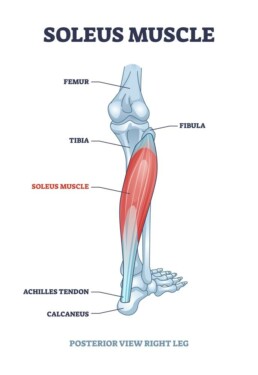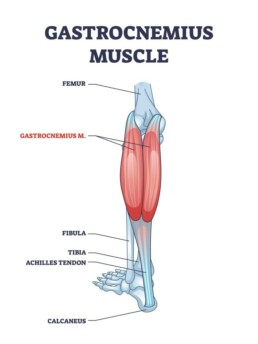If you are diagnosed with a soleus muscle strain (a tear), you may wonder, “What is the soleus muscle?” You’re not alone. The soleus, one of the muscles that makes up the calf muscles, is not as well known as its partner, the gastrocnemius muscles that shape our calf. Soleus muscle pain can be felt as deep soreness or tightness when you press on your Achilles tendon, walk on your tiptoes, or pull your toes toward your shin.
The Soleus Muscle Explained
The name soleus is derived from solea, the Latin word for sandal, appropriate given the muscle’s placement. The soleus muscle is hidden beneath your two-heads of gastrocnemius muscle in your lower leg. It starts at the tibia and fibula bones and combines with the gastrocnemius at the heel to form the Achilles tendon. It is a broad, flat, powerful muscle that is important to maintaining posture and balance; it prevents you from falling forward at the ankle when you are standing and also helps control pronation, or the tendency of your foot to land on its outer edge, rather than plant itself squarely on the ground.


The soleus works with the gastrocnemius to enable plantar flexion, or the ability to point the toes downward; it is largely in charge of plantar flexion when you stand on your toes. It is also known as the soleal pump because it, with assistance from other muscles, pumps deoxygenated blood back from your legs to your heart.


The soleus muscle comprises mostly slow twitch muscle fibres and it is relatively resistant to fatigue, making it valuable in endurance activities such as distance running and walking. However, it is also occasionally involved in explosive movements, so it comes into play in sports such as basketball and tennis.


Causes of Soleus Muscle Pain
Soleus Muscle Pain When Walking
The soleus muscle, along with the other calf muscles, bears a heavy load when you run or walk; it supports a load that is between five and seven times your bodyweight. That’s a lot of pressure! If the soleus muscle fibres aren’t strong enough for the task at hand, it can cause muscle fatigue and tightness in the calf area. In fact, the soleus is one of the most common causes of pain in the calf area.
The soleus muscle is also subject to strain (i.e., tearing). This is generally due to a sudden overload to the muscle, such as a sprint or stepping off a curb, or to repetitive overuse. When there is an acute overload, you will feel soleus muscle pain when walking but may still be able to continue with the activity.
Soleus Muscle Pain Running
This type of strain is most common in sports with sudden acceleration and changes in direction, such as sprinting. It is especially prevalent when someone in a stationary position puts on a sudden burst of speed, as in basketball or football.
When the injury is due to repetitive overuse, the pain will build gradually over time, especially if the muscle is tight. Once it reaches that threshold, the more you continue the activity, the more it hurts. This is an injury common to runners.
When you strain your soleus, you have essentially pulled the muscle beyond the limit of its elasticity, stretching it too far and tearing some of the muscle fibres. The pain may be intense and the area may be tender to the touch, accompanied by bruising and swelling. Walking may be difficult.
Soleus Muscle Pain Treatment
You should begin treatment for your soleus as soon as you feel pain. Initially, you should implement the RICE method: Rest, Ice, Compression and Elevation.
Rest is essential to allowing the injury begin to heal. Depending on its severity, the injury will need rest for two to three days up to as much as two to three weeks.
Apply ice to the injured area for 10-to-15-minute periods at a time, three or four times daily. Don’t put ice directly on bare skin; wrap it first. When not applying ice, wrap the area with a compression bandage, although take it off at night. It will help reduce any swelling and provide support so you don’t injure the soleus further. With regard to elevation, this is most important during the first few days after injury, since keeping your calf raised above the level of your heart draws excess fluid away from your calf.
Next, consult with a registered physiotherapist for a complete evaluation of the injury and the most effective treatment regimen. He/she may suggest that you wear heel pads to keep the heel raised and decrease tension on the muscle. They may also suggest crutches or a rigid boot; it will depend on the severity of the injury.
Your physiotherapist will also suggest a course of exercise to strengthen the muscles so they can heal without being overloaded. They may also prescribe resistance exercises to help the muscle fibres align properly and balance exercises, since a soleus tear can leave you a bit unbalanced.
Strengthening Your Soleus
You can strengthen your soleus muscle as a means of preventing injury. The best options are seated single-leg and double-leg calf raises done with knees bent. You point your toes downward while your knees are bent, preferably at a 90-degree angle. (If you don’t bend your knees, the exercise will target the gastrocnemius muscle instead.)
You can also do standing heel raises by bending your knees about 30 degrees, lifting your heels off the floor and lowering them back down without turning the foot outward.
Treat your soleus muscle with care; it is a vital piece of your anatomy, whether you are a runner or simply aim to get from one place to another!
